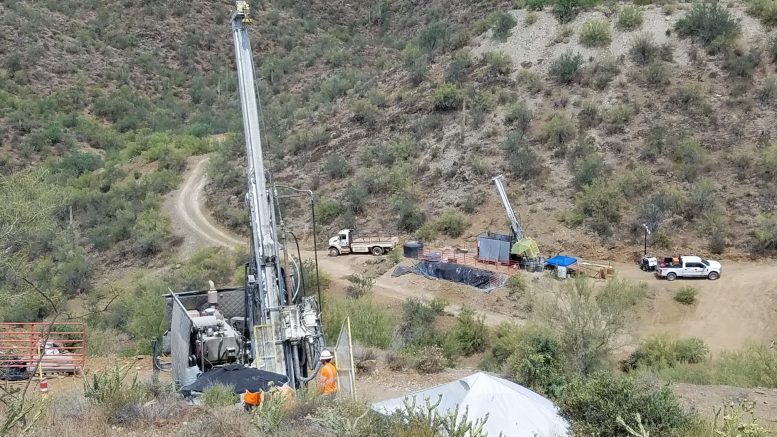Drilling has intersected massive sulphide mineralization at the South zone of Arizona Metals’ (TSXV: AMC) Kay mine property, 69 km north of Phoenix and adjacent to Black Canyon City in central Arizona’s Yavapai County.
Highlights from the drill program include drill hole 20-10, which intersected 5 metres grading 2.16 grams gold per tonne, 24.9 grams silver per tonne, 2.39% copper, 0.31% lead, and 3.27% zinc, (for 6.24% copper-equivalent), starting from 480 metres downhole.
The hole also intersected a high-grade core of 3 metres grading 2.42 grams gold, 28.2 grams silver, 3.66 % copper, 0.32% lead and 3.16% zinc (for 7.78% copper-equivalent).
“KM-20-10 is a trunk hole designed to test the South zone of the deposit at about the 500 metres deep level,” Marc Pais, the company’s president and CEO, said in an interview. “Historic resources at the mine are split between the South and North zones.”
The company, he added, has already started branching off the hole and has completed hole KM-20-10a, which is currently being assayed. Hole KM-20-10b is presently being drilled, with the company planning to add more branch holes in the area.
“The benefit to us is that it increases the speed of drilling because we don’t have to drill down 500 metres each time,” Pais said. “Instead, we can fan out from the drill hole, which saves us time as well as money and also improves the accuracy at depth.”
Hole KM-20-10 is located about 40 metres below the 1,500-foot level of historic underground exploration drifts and 80 metres above hole KM-20-09, which intersected 4.18 grams gold, 41.7 grams silver, 0.12% copper, 0.82% lead and 8.02% zinc (6 metres grading 7.8 grams gold-equivalent).
The phase 1 drill program began in January but was shut down in March due to the Covid-19 outbreak, Pais said.
Drilling then resumed at the end of May with recent drill results representing the resumption of the phase 1 program.
“We completed nine drill holes between January and March, with hole number 10 now part of the restart,” Pais said. “Core samples from holes 11 and 12 are at the lab, and hole 13 is currently being drilled between the North and South zones and is also going to serve as a trunk hole.”

Massive sulphide mineralization in core samples from hole KM-20-10, assays released June 29, 2020. Photo Credit: Arizona Metals.
The company has two drills operating at the property, with the potential for a third, he said. Arizona Metals has also identified two drill targets to the west of the Kay mine, one about 500 metres west and the other about 1,000 metres west, and are currently working on securing drill permits. The plan is to start drilling them towards the end of the year.
The phase 1 program will cover around 7,000 metres in total, of which about 3,000 metres were drilled before the shutdown, with the results from phase 1 to be used to inform the next program of drilling.
“Once we have more core and representative data, we plan to undertake a metallurgical assessment of the mine to see what the metal recoveries are like and will likely form part of the phase 2 program,” Pais said.
Some metallurgical testing, he added, was carried out in the 1950s at the mine with some floatation testing that returned positive results.
The Kay mine was discovered sometime before 1900 and mined on a small scale until 1918. In 1922, the Kay Copper Company extended shafts and underground workings but did not produce any ore.
The project was then acquired by Exxon Minerals in 1972. Exxon invested around US$1.5 million on exploration, drilling 28 exploration holes totalling 9,565 metres between 1972 and 1984, with 18 of the holes in the vicinity of the Kay mine.
In 2017, Silver Spruce Resources (TSXV: SSE) acquired the property. In 2019, Croesus Gold bought the property from Silver Spruce for a total cash consideration of $400,000 and assumed a US$450,000 loan between Silver Spruce and a third-party lender.
“Yavapai County is a prolific mining district and produced about four billion pounds of copper at a grade of 3% [copper] in the past 100 years that came from about 60 underground mines, all of which have shut down now,” Pais said.
The United Verde mine operated by the Phelps Dodge Corporation, he added, is the most famous of these mines and is located around an hour north of Kay mine at Jerome, Arizona. The mine was also a volcanogenic massive sulphide deposit and produced around 30 million tonnes at a grade of 5% copper from an open pit, according to Pais.
In the last years of its life, it became an underground operation and produced 4 million tonnes grading 10% copper and was one of the largest copper mines in the United States, he said.
At press time in Toronto, Arizona was trading at 61¢ per share within a 52-week trading range of 16¢ and 75¢. The company has 64 million common shares outstanding for a $47-million market capitalization.


Be the first to comment on "Arizona Metals hits massive sulphide at Kay mine"